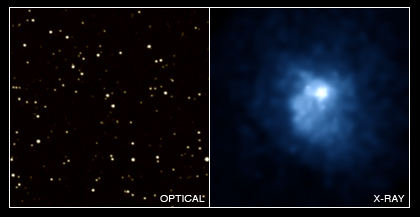For Release: May 30, 2007
CXC Release
Evidence for an awesome upheaval in a massive galaxy cluster was discovered in an image made by NASA's Chandra X-ray Observatory. The origin of a bright arc of ferociously hot gas extending over two million light years requires one of the most energetic events ever detected.
The cluster of galaxies is filled with tenuous gas at 170 million degree Celsius that is bound by the mass equivalent of a quadrillion, or 1,000 trillion, suns. The temperature and mass make this cluster a giant among giants.
"The huge feature detected in the cluster, combined with the high temperature, points to an exceptionally dramatic event in the nearby Universe," said Ralph Kraft of the Harvard-Smithsonian Center for Astrophysics (CfA) in Cambridge, Mass., and leader of a team of astronomers involved in this research. "While we're not sure what caused it, we've narrowed it down to a couple of exciting possibilities."
The favored explanation for the bright X-ray arc is that two massive galaxy clusters are undergoing a collision at about 4 million miles per hour. Shock waves generated by the violent encounter of the clusters' hot gas clouds could produce a sharp change in pressure along the boundary where the collision is occurring, giving rise to the observed arc-shaped structure which resembles a titanic weather front.
"Although this would be an extreme collision, one of the most powerful ever seen, we think this may be what is going on," said team member Martin Hardcastle, of the University of Hertfordshire, United Kingdom.
A problem with the collision theory is that only one peak in the X-ray emission is seen, whereas two are expected. Longer observations with Chandra and the XMM-Newton X-ray observatories should help determine how serious this problem is for the collision hypothesis.
Another possible explanation is that the disturbance was caused by an outburst generated by the infall of matter into a supermassive black hole located in a central galaxy. The black hole inhales much of the matter but expels some of it outward in a pair of high-speed jets, heating and pushing aside the surrounding gas.
Such events are known to occur in this cluster. The galaxy 3C438 in the central region of the cluster is known to be a powerful source of explosive activity, which is presumably due to a central supermassive black hole. But the energy in these outbursts is not nearly large enough to explain the Chandra data.
"If this event was an outburst from a supermassive black hole, then it's by far the most powerful one ever seen," said team member Bill Forman, also of CfA.
The phenomenal amount of energy involved implies a very large amount of mass would have been swallowed by the black hole, about 30 billion times the Sun's mass over a period of 200 million years. The authors consider this rate of black hole growth implausible.
"These values have never been seen before and, truthfully, are hard to believe," said Kraft.
These results were presented at the American Astronomical Society meeting in Honolulu, HI, and will appear in an upcoming issue of The Astrophysical Journal. NASA's Marshall Space Flight Center, Huntsville, Ala., manages the Chandra program for the agency's Science Mission Directorate. The Smithsonian Astrophysical Observatory controls science and flight operations from the Chandra X-ray Center in Cambridge, Mass.
http://chandra.harvard.edu
and
http://chandra.nasa.gov
MEDIA CONTACTS
Steve Roy
Marshall Space Flight Center, Huntsville, Ala.
(Phone: 256/544-6535)
Megan Watzke
Chandra X-ray Center, Cambridge, Mass.
(Phone: 617/496-7998)





